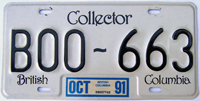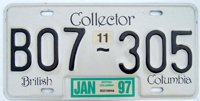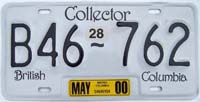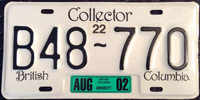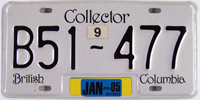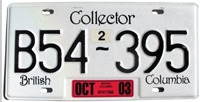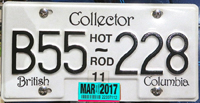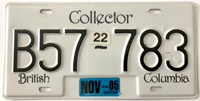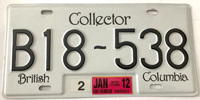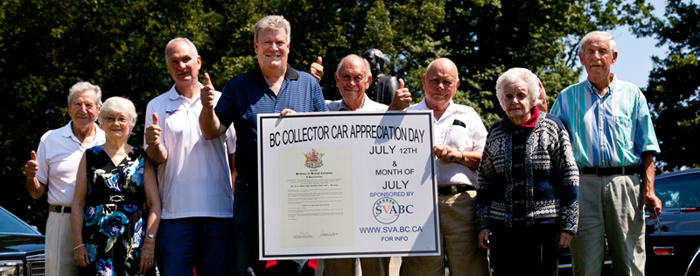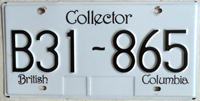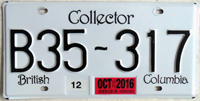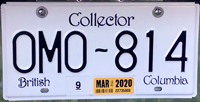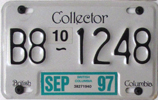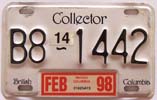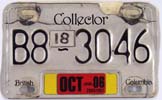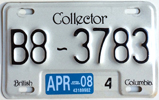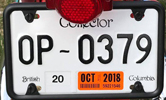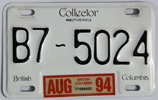|
British
Columbia Collector License Plates


After
24 years of struggling under the restrictive tenets of the Antique license plate program (initiated in 1966) - which limited use only to special events - vintage car owners began to lobby the province in the late 1980s for a more flexible option that would allow them to drive their vehicles more regularly.
 To achieve this, the Vintage Car Club of Canada (VCCC) and Specialty Vehicle Association of BC (SVABC) formed a committee to help develop a "Collector" licensing program and begin lobbying provincial politicians. To achieve this, the Vintage Car Club of Canada (VCCC) and Specialty Vehicle Association of BC (SVABC) formed a committee to help develop a "Collector" licensing program and begin lobbying provincial politicians.
According to Russ Fraser, who was Solicitor General (1990-91) at the time and also a collector of old cars, Claude Richmond, MLA for Kamloops, approached him with the idea for a Collector license plate program. Fraser then raised the idea with Tommy Holmes, then CEO of ICBC, who was "dead set against it" and claimed that neither the police nor the Motor Vehicle Branch (MVB) were in favour of the idea.
Undeterred, Fraser approached local police associations who advised that they had no objections, while the Superintendent of the MVB, Keith Jackman (a classic car enthusiast)supported the introduction of the program.
In his dual roles of Solicitor General and Attorney General, Fraser was able to overrule Holmes' objections, and directed the ICBC CEO to implement the program, thus allowing owners of unique vehicles 25 years and older to obtain Collector license plates (and the the reduced insurance rates that came with them).

|
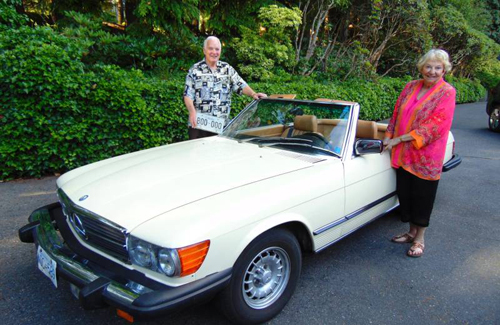 |
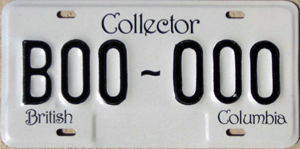 |
Left: Russ Fraser proudly displays collector plate: B00 000 which, while hard to see, is still in its original plastic sleeve. Shown with Russ is his wife Joan and her 1980 Mercedes Benz 450SL which - shock(!) - does not display Collector plates.
Above: A sample Collector plate (Astrographic dies) similar to the one being held by Fraser in the photo at left. While not common, there are a few of these sample plates in the hands of collectors (including Fraser).
|
At the time of its introduction in November of 1990, the press erroneously focused on the first to characters in the license plate - "B0" - and incorrectly interpreted this as "BO" (body odour) and pressed Fraser "if anybody in his department [had] noticed the letters connotations"? Fraser, not realising the press' error, responded that "we are not going to worry about that ... [but] I suppose we could have changed it."
For classic car owners, however, the new program meant they could now qualify for third-party insurance at a rate of 20% regular insurance provided they had another primary vehicle they could use and their collector vehicle is 25 years or older or at
least 15 years old and of a limited production run. 
More specific details on qualifying vehicles can be found at ICBC's web-site. At the time of their release, the 1st plate in the series ("B00-001") was issued to Ron Peigl, who was President of the SVABC and Chaired the Committee that helped to create the plates. According to Nigel Matthews, current President of the SVABC, BC's Collector plate is "one of the best programs in North America, if not the best".
|
| Passenger: 1st Bloc (1990 - 1994) |
|
|
|
Issuing
Statistics |
1990-94:
|
B00-001 to B09-999 |
|
|
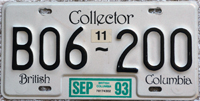 |
|
|
| Passenger: 2nd Bloc (1994 - 2002) |
|
|
|
Issuing
Statistics |
1994-2002:
|
B40-000 to B49-999 |
|
|
|
|
|
| Passenger: 3rd Bloc (2002 - 2007) |
|
|
|
Issuing
Statistics |
2002-07:
|
B50-000 to B59-999 |
|
Plates from the mid-B54-000
bloc display Waldale dies. |
|
|
|
When the Collector plate program first started in 1990, owners of collector vehicles to adhere to original manufacturer’s
specifications, making modified vehicles ineligible for collector vehicle status. |
This was changed in 2000 when the the criteria for "Custom" cars to be eligible were introduced provided the car was manufactured prior to 1948. |
This changed again on May 18, 2006, when (then) Solicitor General John Les announced that 1958 and older “hot rods” and “custom” vehicles could be registered as Collector cars. |
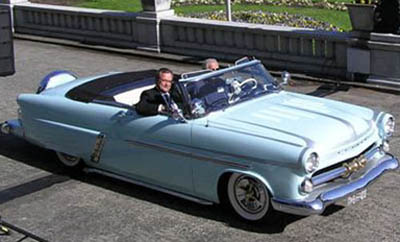 |
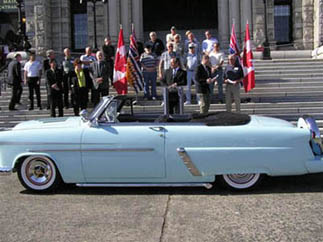 |
John Les arriving at the steps of the Legislature in Victoria on May 18, 2006,
to announce an expansion to the Collector license plate program.
|
|
According to Les, "“The era of drive-in movies, the cold war, civil rights and rock and roll was also a time of glorious
cars that are still much loved and cherished today. That’s why we’re expanding the eligibility time
frame for collector cars from 1948 to 1958, and allowing a larger pool of vehicles to qualify for the collector
motor vehicle program." |
This announcement would see an increase in the issuance of Collector plates so that the 4th Bloc of 10,000 plates (B10-000 to B19-999) would be exhausted in a record pace of only four years! |
| Passenger: 4th Bloc (2007 - 2010) |
|
|
|
Issuing
Statistics |
2007-10:
|
B10-000 to B19-999 |
|
|
|
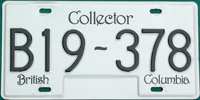 |
|
.jpg) |
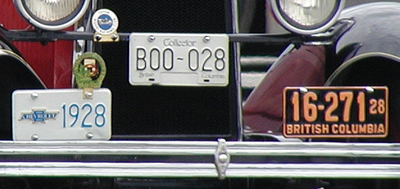 |
Not quite a natural hat-trick, but impressive nonetheless! Shown here is a 1928 Chevy displaying a 1928 passenger plates (naturally), a 1928 booster plate (with what look to be Astrographic dies) as well as the 28th Collector plate issued in the series (nice!).
|
| Passenger: 5th Bloc (2010 - 2014) |
|
|
|
Issuing
Statistics |
2010-14:
|
B20-000 to B29-999 |
|
|
|
|
Dual decal wells are thought to have appeared on the Collector plates between plate No. B27-469 & B27-489. |
| Passenger: 6th Bloc (2014 - TBD) |
|
|
|
|
|
|
|
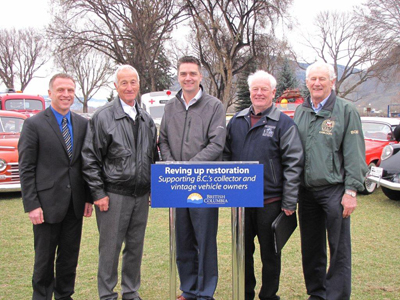 |
We are assuming that this is a big deal as it warranted a press release from the province; apparently it is going to be easier to register a collector vehicle purchased out of province for restoration purposes.
Prior to this change, some individuals were purchasing such cars, sinking considerable money into restoring them without being sure that they would ever be able to register them.
At left is Minister Todd Stone (centre) along with some folks from the Vintage Car Club and Mark Francis (ICBC).
Press Release
|
On August 8, 2016, the government announced changes to the Collector program so that modified cars made between 1958 and 1974 will be eligible starting in 2017 as will replica cars resembling North American production cars from 1942 and earlier. |
According to Minister Todd Stone, "we want to see this specialty vehicle program remain viable, preserve vehicle history and evolve with the times. That's why we are opening up the opportunity to owners of specialty cars within the 'muscle car' era." |
| |
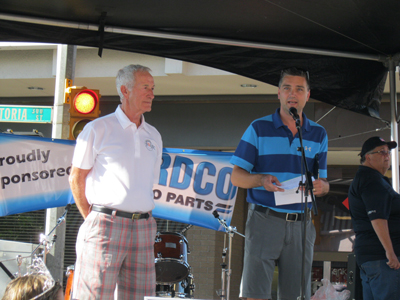 |
Minister Stone announcing the change along with SVABC Director Bob Kelly in Kamloops on August 6, 2016.
|
|
For our purposes, we are expecting there to be another up tick in the number of Collector plates being issued on an annual basis, much like what happened after the last change to eligible model years (from 1948 to 1958) that was announced in 2006 - a point confirmed in a news story on the 2016 announcement which cited that "registered collector vehicles ... doubled to 26,000 in the past 10 years." |
In an article that appeared in the Langley Times on September 13, 2016, covering the Good Times Cruise-In held in that community was an interesting statistic that Langley was the Hot Rod Capital of BC (No surprise to Cruise-In president — Langley is hot rod capital of B.C.). The basis for this claim? The number of Collector license plates issued in that community on a per capita basis - which is the highest in the province at 1 for every 100 residents of the City and Township (Delta was second with 0.874 per 100 and Saanich was third with 0.821). |
Naturally, this prompted us to put in a request to ICBC to share the information quoted by the Langley Times and, much to our surprise, the Corporation came through for us (click on the image above-right)! |
Langley does in deed of a high number of Collector plates, as does Qualicum Beach given its relatively small size. Of more interest, the list is from August of 2015, so is already 12 months out-of-date. Would be interesting to see this same list again in August of 2017 after the changes allowing modified cars up to 1974 to be eligible. |
 With the release of a new Licence Plate Identification Guide by ICBC in March of 2017, an interesting reveal regarding the future of the Collector plate was made, namely the new serial format; 0A0-000! The format is the same used on the Off Road Vehicle (ORV) plates and helps to explain why that serial started with a "B" (i.e. "0B0-000") and further indicates that the change to this format was likely established some time ago (at least by 2014). What is less clear is when we might expect to see this serial begin to be issued as the high in February 2017 was in the mid-B36-000's. It likely won't be until 2018 that we see these plates. With the release of a new Licence Plate Identification Guide by ICBC in March of 2017, an interesting reveal regarding the future of the Collector plate was made, namely the new serial format; 0A0-000! The format is the same used on the Off Road Vehicle (ORV) plates and helps to explain why that serial started with a "B" (i.e. "0B0-000") and further indicates that the change to this format was likely established some time ago (at least by 2014). What is less clear is when we might expect to see this serial begin to be issued as the high in February 2017 was in the mid-B36-000's. It likely won't be until 2018 that we see these plates. |
| Passenger: 7th Bloc (2018?) |
|
|
|
Issuing
Statistics |
2018?:
|
0A0-000 to 9A9-999 |
|
|
|
|
|
"Multi-Vehicle"
Collector plates are used by people who have multiple vintage
cars, but only want to use one license plate for all of them
(obviously, this limits how many cars they can take to a show!).
Apart from the registration numbers, these plate differ from
other "Collector" plates in that they state "Multi
Vehicle" under the "Collector" title at the
top of the plate. |
| Unauthorised Reproductions |
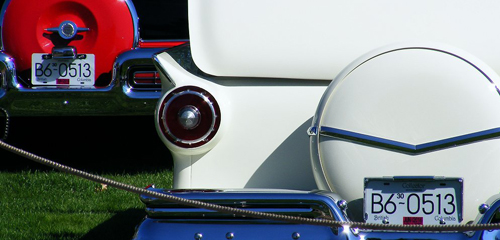 |
One wonders sometimes about abuse of the "Multi-Vehicle" Collector plates ... well, shown at left is a possible example.
Not only have a set of plates (i.e. same number: "B6-0513") been split-up and used on two different vehicles, but if you look closely you can see that the plates are fakes!
Best we can tell, these have been printed out on a high quality card stock and while this person has obvious skill, the dies are not quite accurate representations of the Waldale dies currently used on the Collector plates.
|
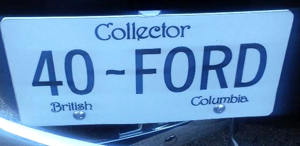 |
 |
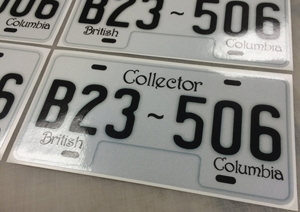 |
Similar to the "Single License Debate" for regular passenger plates, classic car owners have similar problems/issues with front license plates when there cars do not have mounts to place them. To get around this, some sign makers in the province offer digitally printed license plates on white reflective vinyl that are similar to actual license plates and can be affixed without the use of screws. The potential for abuse is obvious ... |
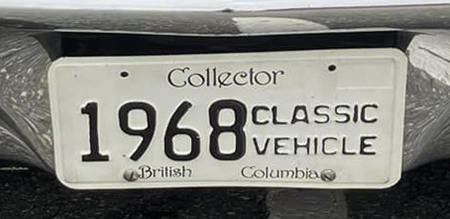 |
In 2024, an interesting example of a BC "Collector" plate showed up at local car show and appeared to present a whole new design for this particular plate series.
For sharp eyed plate collectors, however, the "Collector" plate No. 1968 is nothing more than a creative work of art using a 1990s Souvenir plate issued by the State of Nevada and available to anyone willing to put down $20.
We know this by the design of the design of the plate and the use of the "CLASSIC VEHICLE" text at right.
We also strongly suspect the use of a Souvenir plate - which is always identifiable by the red text - as this is really the only way to get your desired year on a plate in order to match your car's year of manufacturer (e.g. Nevada also lest people personalize souvenir plates with their own slogan).
Full credit to this particular car owner for taking the time to modify the Nevada plate in order to resemble a BC plate, including the procurement of the "Collector" decals (we assume from the decal folks profiled above).
|
|
| Temporary Number Plate - Multi-Vehicle Collector |
In March of 2020, ICBC allowed for the issuance of paper Temporary Number Plates as a response to the Covid-19 provincial health emergency and restrictions on meetings. Below is an example of what we presume is a rare Multi-Vehicle Collector plate issued as a TNP to be used while the actual plates were in the mail. |
|
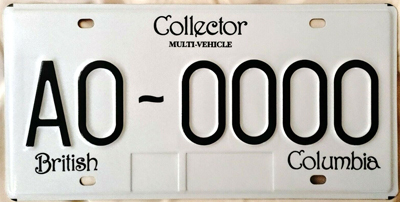 |
An interesting example of a manufacturer's specimen that appeared on eBay in 2020. It appears that these were sent to ICBC by Waldale and the Corporation was required to sign off on the design, presumably before Waldale would mass produce the design. It is assumed that these were produced to show the dual decal well. |
1990
- 2008: Motorcycle (Astrographic dies) |
|
|
|
|
|
|
|
|
|
|
|
|
|
As of August 1, 2009, the
high plate in the series was B8-7464. It is thought that the
first batch manufactured ran from B8-0001 to B8-5000 utilising
Astrographics dies. The first Waldale dies did not begin appearing
until 2007. |
2018 to present: Motorcycle |
|
|
|
|
|
1990
- 2013: "Motorcycle Floater"
|
|
|
|
|
|
The "Multi-Vehicle"
Collector equivalent for motorcycle plates, this type is even
more exceedingly rare than its passenger plate counterpart
and it is unlikely that more than a few hundred will ever
be issued under this format. |
|
| Sources |
| Vancouver Sun Newspaper |
| Dan Howlett, "Decoding British Columbia
License Plates", http://www.kasumirecords.com/bcplates/index.htm
(October 28, 2001). |
| Insurance Corporation of British Columbia,
http://www.icbc.com (October 28, 2001). |

© Copyright Christopher John
Garrish. All rights reserved.
|

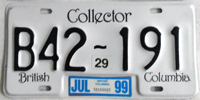
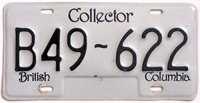


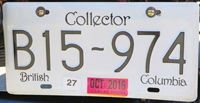

.jpg)

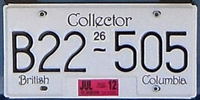



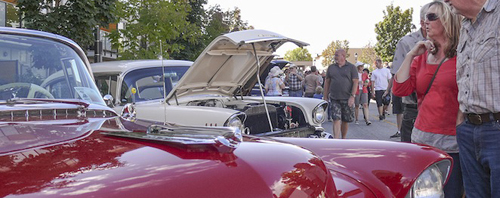


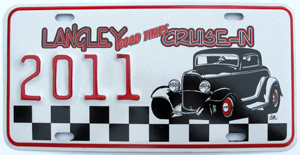









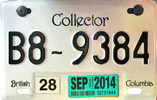
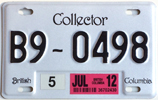
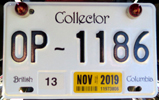


 To achieve this, the Vintage Car Club of Canada (VCCC) and Specialty Vehicle Association of BC (SVABC) formed a committee to help develop a "Collector" licensing program and begin lobbying provincial politicians.
To achieve this, the Vintage Car Club of Canada (VCCC) and Specialty Vehicle Association of BC (SVABC) formed a committee to help develop a "Collector" licensing program and begin lobbying provincial politicians. 




